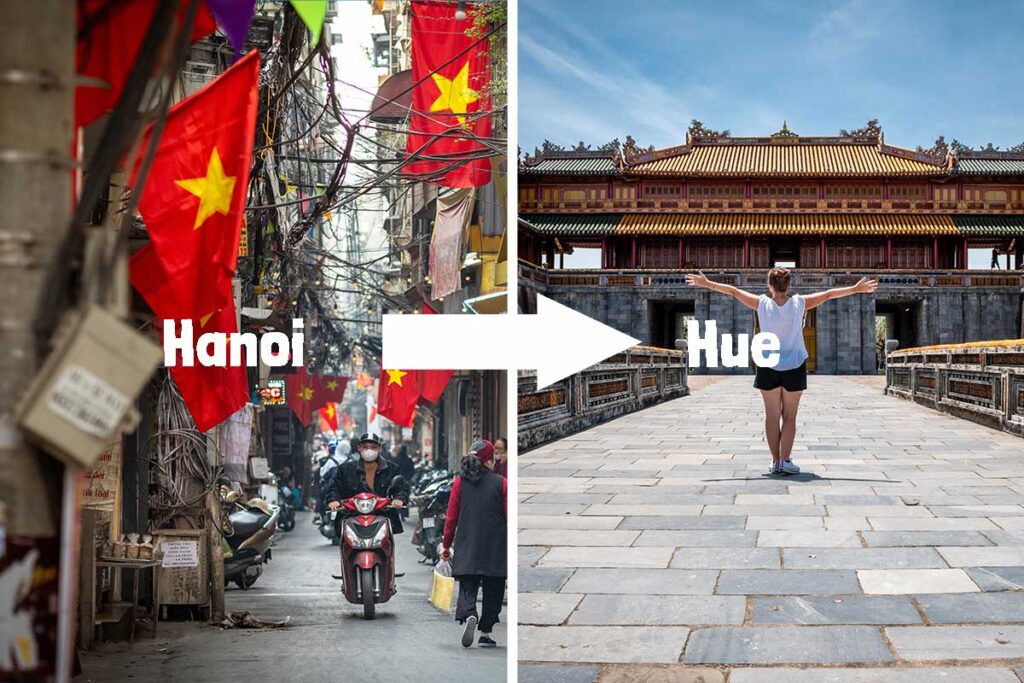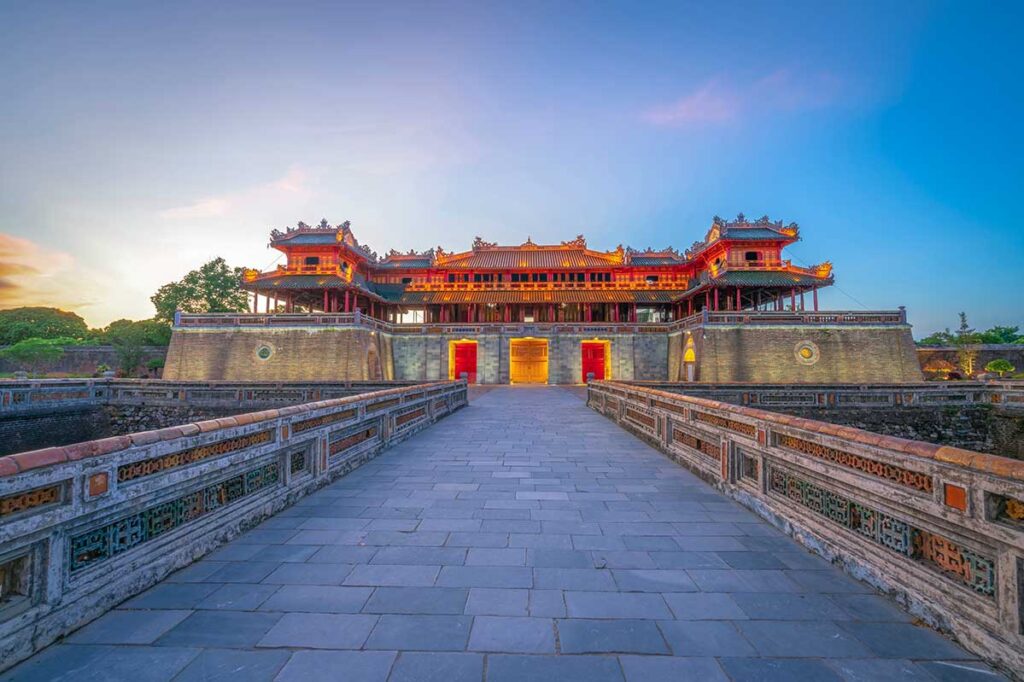About the route from Hanoi to Hue
Distance and Travel time
Traveling from Hanoi to Hue means covering roughly 670–700 km through northern and central Vietnam. The quickest option is a flight, which takes about 1 hour and 10–15 minutes, but you’ll still need to factor in airport transfers. The train and sleeper bus both take around 12–14 hours, making them more of a long-haul journey than a quick hop. Driving by private car takes around 11 hours even without stops, so it’s not a trip most travelers would want to do in a single day.
Destinations along the way
If you’re not in a rush and want to turn the trip into part of your Vietnam experience, there are a few worthwhile stops between Hanoi and Hue:
- Ninh Binh – About 90 km south of Hanoi. Known for its dramatic limestone karsts, peaceful countryside, and boat rides in Trang An or Tam Coc. A great overnight stop if you want scenery and relaxed rural charm.
- Phong Nha (via Dong Hoi) – Further south in Quang Binh Province, this area is famous for its cave systems, including Paradise Cave and Phong Nha Cave. You’ll need to reach Dong Hoi by train or bus, then continue inland.
- Quang Tri (DMZ area) – Best known for Vietnam War history sites like the Vinh Moc Tunnels and Hien Luong Bridge. It’s easiest to visit here when traveling by private car or as part of a guided tour.
Other cities along the route, such as Vinh or Thanh Hoa, are mainly transit hubs and don’t have much to offer most international visitors.
Pro Tip: Private sightseeing transfer with highlights
At Local Vietnam, we’ve created a unique multi-day transfer package that takes you from Hanoi all the way to Hoi An, visiting Hue and many incredible places in between. There’s so much to see along this route — from limestone mountains and ancient citadels to stunning caves and historic war sites — but with so many different connections and activities to arrange, it can be tricky to organize everything yourself. Our package combines trains, limousine vans, and private cars into one smooth journey, so you can enjoy the highlights without the hassle.
Here’s how the trip flows:
- Hanoi → Ninh Binh (by limousine van with local guide) – Visit Mua Cave viewpoint, cycle through the countryside, take a Trang An boat ride, and explore Hoa Lu Ancient Citadel. Overnight in Ninh Binh.
- Free time or extra sightseeing in Ninh Binh – Relax at your accommodation or add activities like the Tam Coc boat ride or more cycling. In the evening, take the overnight train to Dong Hoi.
- Dong Hoi → Phong Nha National Park (private transfer) – Explore Paradise Cave in the morning, then enjoy a boat trip into Phong Nha Cave. Overnight in Phong Nha.
- Phong Nha → Hue (private car via DMZ) – Stop at Vinh Moc Tunnels and Hien Luong Bridge before arriving in Hue. Afternoon at leisure.
- Full-day Hue city tour (small group or private) – Dragon boat on the Perfume River, Thien Mu Pagoda, Imperial City, Dong Ba Market, Ming Mang and Khai Dinh tombs, plus incense and conical hat villages. Overnight in Hue.
- Hue → Hoi An (private car via Hai Van Pass) – Scenic coastal drive with stops at Lap An Lagoon, Lang Co Beach, and the Marble Mountains. Drop-off at your Hoi An hotel.
This way, you’ll experience the very best between Hanoi and Hoi An in one seamless, well-organized trip.
Option 1: Flight from Hanoi to Hue
How it works
Flying from Hanoi to Hue is by far the quickest way to cover the distance, with around 7–10 direct flights each day operated by Vietnam Airlines and VietJet Air. The flight itself takes about 1 hour and 10–15 minutes, but you’ll need to factor in travel to and from the airports and time for check-in. Prices for a one-way ticket usually range from 750,000 to 1,500,000 VND (about 30–60 USD), depending on the airline, season, and how far in advance you book.
Phu Bai International Airport (HUI)
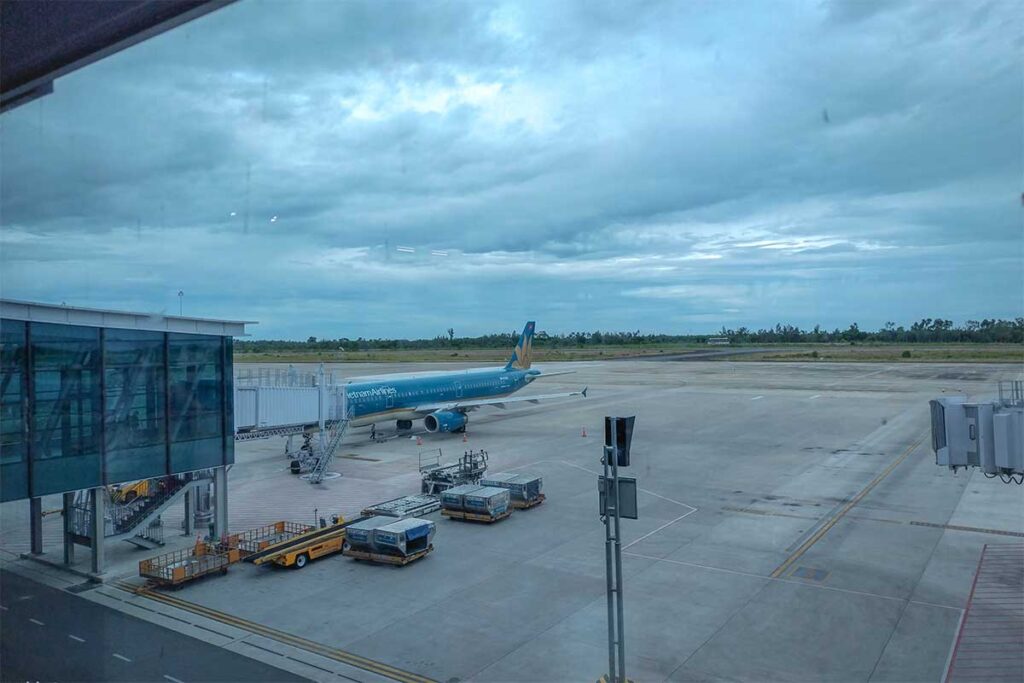
Flights arrive at Phu Bai International Airport, located roughly 16 km south of Hue city center. The drive into town takes around 25–30 minutes. The easiest options for getting to your hotel are taxi, Grab, or a pre-arranged private transfer. Taxis and Grab are generally reliable, but a fixed-price transfer can be convenient if you prefer to avoid negotiating fares after a flight.
Booking flight tickets
The simplest way to book is directly through the airlines:
- VietJet Air – Usually the cheaper choice, but baggage is often not included in the base fare, so check carefully before booking.
- Vietnam Airlines – The national carrier, typically offering more legroom, complimentary baggage, and a higher service level.
If your schedule is fixed, booking early often secures the best prices. For flexible itineraries, you can watch for flash sales — especially from VietJet — but be aware these can sell out quickly.ween Hanoi and Hoi An via Hue in one seamless, well-organized trip.
Option 2: Train from Hanoi to Hue
How it works
Taking the train from Hanoi to Hue is one of the most popular ways to travel between the two cities. It’s a scenic route that passes countryside, mountains, and stretches of coastline, making it an experience in itself rather than just transport.

The journey takes around 12–14 hours depending on the train type — SE trains are faster and more modern, while TN trains are older and slower. Ticket prices range from 400,000 to 1,400,000 VND (about 16–55 USD), depending on the seat or berth class you choose.
Train options
- Regular Vietnam Railways trains – Reliable and widely used; the SE1 and SE3 are recommended.
- Tourist trains – Private operators such as Livitrans and Violette attach upgraded carriages to SE trains. They offer cleaner cabins, softer bedding, and small extras like bottled water and snacks, but cost more.
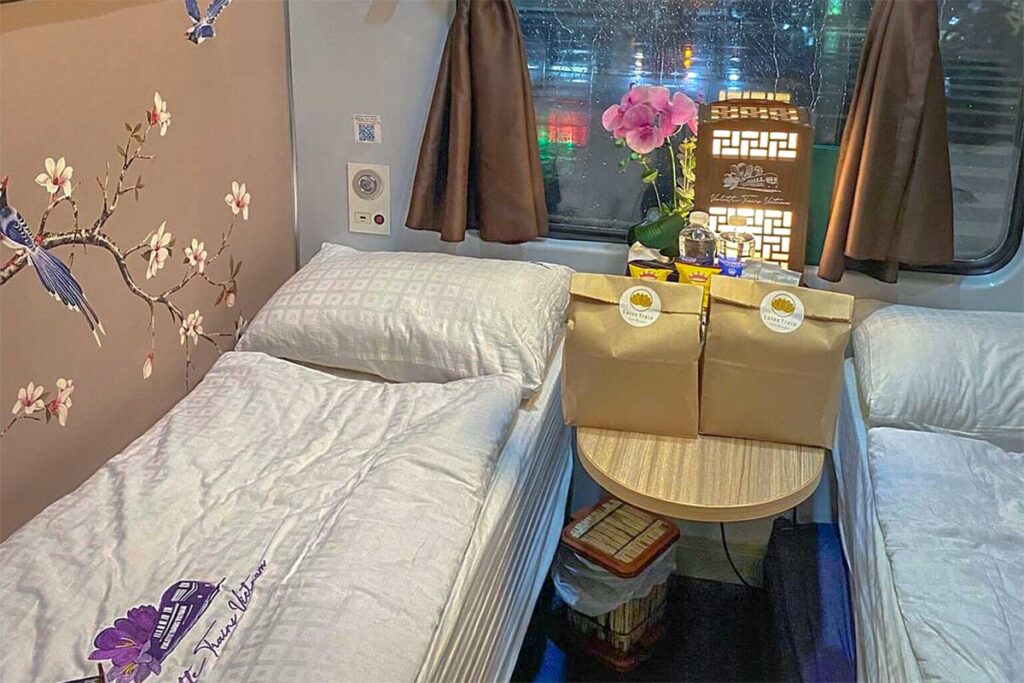
Cabin and seat options
- Hard seat (AC) – Cheapest, padded but basic; not ideal for overnight travel.
- Soft seat (AC) – More comfortable for daytime journeys, with reclining seats.
- Hard sleeper (AC) – Six berths per cabin (three tiers). Upper berths are cheapest, lower berths most comfortable.
- Soft sleeper (AC) – Four berths per cabin (two tiers), offering more space and comfort.
- Tourist train soft sleeper – Usually 4-berth.
Tip: You can book the entire cabin for more privacy.
How to book the train
- Regular trains – Book directly on the Vietnam Railways official site.
- Tourist trains – Book via the company’s own website or through platforms like Baolau or 12Go Asia. These platforms are convenient for foreign cards and show both regular and tourist options side by side.
Tip: For an overnight trip, most travelers choose a soft sleeper. It’s more expensive, but arriving in Hue rested is worth the upgrade.
Option 3: Direct Bus from Hanoi to Hue (Not Recommended for Most)
How it works
You can travel from Hanoi to Hue by overnight sleeper bus or limousine sleeper. Both have reclining berths rather than seats, and some newer luxury services offer capsule-style bunks with curtains. The journey takes around 12–14 hours depending on traffic and rest stops. Tickets usually cost 450,000–900,000 VND (about 18–36 USD).
Bus options
There are a few different sleeper bus types available on the Hanoi to Hue route:

Standard sleeper buses – The most common option, with two or three rows of reclining berths in an open-plan layout. Basic but functional.
Limousine sleeper buses – Upgraded buses with wider bunks, fewer passengers, and added amenities such as USB charging points and sometimes onboard toilets.
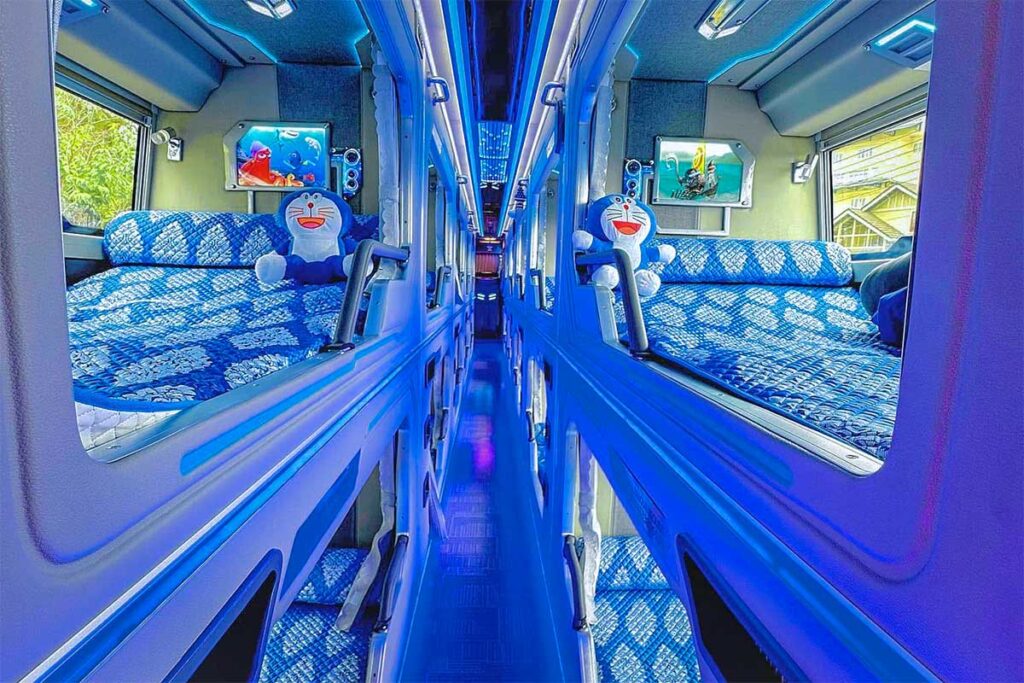
VIP cabin buses – The most private option, with individual enclosed “cabins” that include a bed, curtain or door, and personal entertainment screens. More expensive but offers greater comfort and privacy for the long ride.
Why it’s not ideal
While buses are often cheaper than trains or flights, the long overnight ride can be exhausting — especially if you’re tall or prefer more personal space. Sleeper berths are narrow and designed for the average Vietnamese height, making them cramped for many foreign travelers. Rest stop facilities can range from basic to very basic, and you may not get a full night’s sleep.
How to book
Tickets can be bought through company websites, at local ticket offices in Hanoi, or via online platforms such as Vexere and 12Go Asia. Booking online gives you a better chance to compare bus types, prices, and departure times.
Tips for traveling from Hanoi to Hue
Car options from Hanoi to Hue
Driving from Hanoi to Hue takes around 11 hours without stops, so it’s not a realistic journey to do in one go for most travelers. The better option is to split it over two days, but unless you plan detours to major attractions like Ninh Binh or Phong Nha, there aren’t many places along the direct route worth an overnight stay. This is why a direct private car isn’t listed among our main recommendations for traveling from Hanoi to Hue.
How long to stay in Hue
If you just want to see the main sights — such as the Imperial City, a pagoda or two, and one of the royal tombs — one full day is usually enough before continuing to Hoi An or Da Nang. History enthusiasts or those who enjoy a slower pace may prefer 2–3 days, which allows time for side trips to the DMZ or Bach Ma National Park. For a detailed plan, see our 1 Day in Hue guide for making the most of a short stay.
Where to go next
If you’ve come from Hanoi, it’s most common to continue south from Hue:
- Da Nang – About 100 km from Hue, Da Nang is known for its long sandy beaches, the Marble Mountains, and its role as the gateway to the Hai Van Pass, one of Vietnam’s most scenic coastal roads. You can travel there by car, motorbike, train, or bus.
- Hoi An – Around 126 km from Hue, Hoi An is a UNESCO-listed ancient town famous for its preserved architecture, lantern-lit evenings, tailor shops, and riverside charm. Most travelers combine it with Da Nang, either stopping there en route or using it as a base.
